Early last month, the Central Advisory Board of Education unanimously adopted the National Policy on ICT in School Education (NPISE). For cruelly neglected Indian primary, secondary and higher education, ICT offers a magical opportunity to rapidly create 21st century learning environments. Vimal Joshi & Summiya Yasmeen report
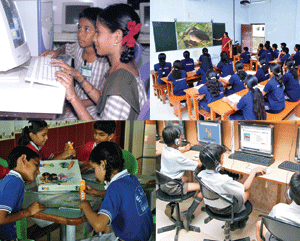 Although India’s spectacular — by the yardsticks of the country’s bullock-cart econnomy — IT revolution is almost three decades old and has transformed the grammar of Indian industry, the impact of its spin-off ICT (information and communications technology) has been much less dramatic. Despite the buzz and hype generated by new technologies education companies and government about ICT revolutionising Indian education, the reality in the classrooms and lecture halls of India’s 1.30 million schools, 611 universities and 31,000 colleges is very different.
Although India’s spectacular — by the yardsticks of the country’s bullock-cart econnomy — IT revolution is almost three decades old and has transformed the grammar of Indian industry, the impact of its spin-off ICT (information and communications technology) has been much less dramatic. Despite the buzz and hype generated by new technologies education companies and government about ICT revolutionising Indian education, the reality in the classrooms and lecture halls of India’s 1.30 million schools, 611 universities and 31,000 colleges is very different.
According to Elementary Education in India 2010-11, published by the Delhi-based National University of Educational Planning and Administration (NUEPA), 81.3 percent (1.05 million) of India’s 1.30 million schools don’t have computers — the basic tool for ICT delivery. Of the remaining 18.7 percent (243,000) which have introduced computers to their students, a majority are in the private sector indicating a huge digital divide between private and government schools with the latter having been completely bypassed by the computer-aided learning (ICT) revolution. Inevitably, the situation is better in higher education institutions with the National Mission on ICT in Education (NMEICT), launched in 2009 by the Central government “to leverage the potential of ICT for the benefit of all the learners in higher education institutions in any time any where mode,” providing internet connectivity to 390 universities and 14,578 colleges countrywide.
Yet unfazed by the tepid response of government schools and colleges to the high-potential ICT revolution and other depressing statistics (52.75 percent of schools don’t have electricity, 12 percent are single-teacher schools and 42.75 percent do not provide book banks i.e. libraries) of Indian primary and secondary education, ICT education companies — hitherto blue-chips of the stock exchanges — are flooding the market with teaching-learning equipment such as interactive display boards, language laboratories, digital content and educational software. According to industry sources, the ICT in education market in India is estimated at Rs.285,000 crore ($50 billion) and expected to grow to Rs.570,000 crore ($100 billion) by 2014.
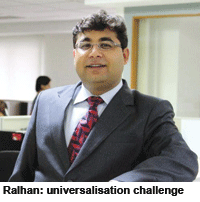 “There’s unanimity that technology-based solutions are the key to revitalising India’s education system and making its future generation globally competitive. The challenge is how effectively and quickly we integrate digital technologies into our education system. As per our estimates, a majority of India’s 70,000 plus private schools have invested in some form of digital infrastructure though there are still challenges around availability of integrated platforms and under-utilisation of technology. The challenge in education is delivering quality education to all. This can be addressed through ICT in a very cost-effective manner. The good news is that the government is focusing on bridging the digital divide through initiatives such as the RTE Act, Sarva Shiksha Abhiyan and allocation of nearly $1 billion in the 11th Plan for the National Mission on Education through ICT. Moreover, the recently drafted National Policy on ICT in School Education of the Union HRD ministry contains a roadmap for implementing ICT literacy in all schools, and we are hopeful that technology will become a reality in education sooner than later,” says Beas Dev Ralhan, an alumnus of IIT-Bombay and chief executive of Next Education India Pvt. Ltd, a Hyderabad-based education technology company offering products and services to 4,000 schools countrywide with an aggregate enrolment of 3 million students (see box).
“There’s unanimity that technology-based solutions are the key to revitalising India’s education system and making its future generation globally competitive. The challenge is how effectively and quickly we integrate digital technologies into our education system. As per our estimates, a majority of India’s 70,000 plus private schools have invested in some form of digital infrastructure though there are still challenges around availability of integrated platforms and under-utilisation of technology. The challenge in education is delivering quality education to all. This can be addressed through ICT in a very cost-effective manner. The good news is that the government is focusing on bridging the digital divide through initiatives such as the RTE Act, Sarva Shiksha Abhiyan and allocation of nearly $1 billion in the 11th Plan for the National Mission on Education through ICT. Moreover, the recently drafted National Policy on ICT in School Education of the Union HRD ministry contains a roadmap for implementing ICT literacy in all schools, and we are hopeful that technology will become a reality in education sooner than later,” says Beas Dev Ralhan, an alumnus of IIT-Bombay and chief executive of Next Education India Pvt. Ltd, a Hyderabad-based education technology company offering products and services to 4,000 schools countrywide with an aggregate enrolment of 3 million students (see box).
The policy initiative which has buoyed Ralhan’s optimism was confirmed on June 6 when at its 59th meeting held in Delhi the Central Advisory Board of Education (CABE), chaired by Union human resource development (HRD) minister Kapil Sibal, unanimously adopted the National Policy on ICT in School Education (NPISE). The policy document circulated to the public for comment in early 2011, envisages the introduction of a phased ICT literacy programme in all primary and secondary schools country-wide within the 11th (2007-12) and 12th Plan (2012-17) periods. The 11th Plan document allocated Rs.6,000 crore (up from Rs.1,000 crore in the 10th Plan) for this initiative.
The first NPISE draft of 2008 drew flak from educationists for being too focused on equipping schools with computer hardware and software rather than integrating ICT into pedagogy and teaching-learning processes and was sent back for redrafting by the HRD ministry.
“NPISE over its multiple avatars offers a good case study of the complexities of ICT policy and programme design in the development sector. The first draft released in January 2008 by a committee that included representatives of Microsoft, Intel, Educomp, NIIT — all vendors with a vested interest in the ICT in school education ‘market’ — had very little discussion on core educational issues and focused largely on technology challenges of infrastructure and business models. Therefore CABE set up a committee to investigate the issue of ‘vendor driven ICT policy and program’ and the first draft was rejected by the HRD ministry. The final NPISE draft accepted by CABE recently, stresses the need for developing a free and open digital resource learning environment. Such a free and open environment, while not appreciated by technology vendors milking super profits from the public education system, enables teachers and teacher educators to become collaborators in content creation and resource enrichment,” says Gurumurthy Kasinathan, founder-director of Bangalore-based NGO IT for Change (estb. 2000).
 The almost non-existent ICT teaching-learning scene in the country’s government schools which do boast ICT hardware, is a strong argument for state governments to shift focus from hardware and software purchases to integrating ICT into teacher training and classroom pedagogies. During the past five years, every self-respecting state government in the country has jumped onto the ICT bandwagon, buying computers/educational software for its schools from the multiplying number of ICT education vendors (Educomp Solutions Ltd (estb. 1994), one of the country’s pioneer ICT education corporates, boasts of working with 12 state governments and recently bagged a Rs.200 crore contract from the Assam government). But once purchased, expensive ICT hardware is often locked up in secure strong rooms with neither teachers nor students utilising it for fear of damage to equipment and/or lack of training.
The almost non-existent ICT teaching-learning scene in the country’s government schools which do boast ICT hardware, is a strong argument for state governments to shift focus from hardware and software purchases to integrating ICT into teacher training and classroom pedagogies. During the past five years, every self-respecting state government in the country has jumped onto the ICT bandwagon, buying computers/educational software for its schools from the multiplying number of ICT education vendors (Educomp Solutions Ltd (estb. 1994), one of the country’s pioneer ICT education corporates, boasts of working with 12 state governments and recently bagged a Rs.200 crore contract from the Assam government). But once purchased, expensive ICT hardware is often locked up in secure strong rooms with neither teachers nor students utilising it for fear of damage to equipment and/or lack of training.
For instance in the southern state of Karnataka, which has expended Rs.72.02 crore over the past ten years to purchase ICT hardware for its 3,280 government schools, an audit report has unearthed shocking facts about ICT usage in government schools. The audit conducted by the South India Cell for Human Rights Education and Monitoring (SICHREM) and the National Commission for Protection of Child Rights (NCPCR) to measure the extent to which 47 government, municipal and aided primary schools in Bangalore have complied with the provisions of the historic Right to Free & Compulsory Education Act, 2009 (aka RTE Act), revealed that ICT equipment is securely locked up and unutilised in all the surveyed schools.
 “New technologies aided education in Karnataka’s government schools exists only at the policy level. In most schools surveyed in the audit, computers were gathering dust in locked rooms adjacent to the headmaster’s office. In others, the computers were rendered useless by the state’s erratic power supply system. Teachers aren’t trained to use ICT, nor do schools employ part-time computer teachers. Children too, are afraid to explore or even play games on computers fearing reprimand. If this is the situation in government schools in the IT city of Bangalore, it’s surely much worse in rural areas. It’s a sorry situation and waste of meagre government resources with ICT hardware and software used for status symbol purposes rather than for improving teaching-learning in class-rooms,” says Gangadhara Reddy, the Bangalore-based district coordinator — Social Audit (RTE) of SICHREM.
“New technologies aided education in Karnataka’s government schools exists only at the policy level. In most schools surveyed in the audit, computers were gathering dust in locked rooms adjacent to the headmaster’s office. In others, the computers were rendered useless by the state’s erratic power supply system. Teachers aren’t trained to use ICT, nor do schools employ part-time computer teachers. Children too, are afraid to explore or even play games on computers fearing reprimand. If this is the situation in government schools in the IT city of Bangalore, it’s surely much worse in rural areas. It’s a sorry situation and waste of meagre government resources with ICT hardware and software used for status symbol purposes rather than for improving teaching-learning in class-rooms,” says Gangadhara Reddy, the Bangalore-based district coordinator — Social Audit (RTE) of SICHREM.
Arguably India’s most IT literate state with its administrative capital Bangalore (pop. 8 million) often described as the Silicon Valley of India, Karnataka is certainly not an exception. Similar reports of “locked-up” ICT hardware in government schools are routine from all states countrywide. The failure of state governments to invest in sustained teacher training and pedagogy revision has resulted in this bizarre situation of expensive unutilised or under-utilised ICT hardware. ICT training for government school teachers is restricted to short-term (one-two weeks) familiarisation workshops conducted gratis by IT majors such as Microsoft and Intel which have ‘trained’ 700,000 and 1 million teachers respectively. But this is seldom followed up by in-service training for teachers, most of whom are reluctant to adapt to new ICT-driven pedagogies.
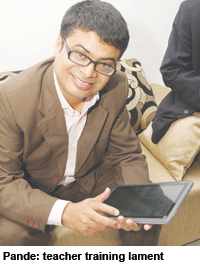 Comments Rohit Pande, chief executive officer of the Delhi-based Mind Shaper Technologies Pvt. Ltd, whose Classteacher Learning Systems division offers interactive whiteboards, teaching and assessment solutions, and labs apart from consultancy services to over 600 schools, 1 million students and 25,000 educators, and has recently launched its computer tablet Classpad: “Teacher resistance to new ICT technologies is a huge problem. Recently when we tried to introduce our Class-pads in 30 schools in Delhi, Baroda, Nagpur, Bhopal, Trichy and Guwahati, there was strong teacher resistance. It was only after regular visits by the company’s representatives over a period of three-four months that we managed to persuade teachers that our new technologies are teacher and student friendly. Unfortunately teacher training curriculums offered by the country’s B.Ed colleges are hopelessly out-of-date and ICT ignorant. Sustained in-service teacher training by experts is a vital prerequisite of introducing new technologies into the country’s classrooms and improving learning outcomes.”
Comments Rohit Pande, chief executive officer of the Delhi-based Mind Shaper Technologies Pvt. Ltd, whose Classteacher Learning Systems division offers interactive whiteboards, teaching and assessment solutions, and labs apart from consultancy services to over 600 schools, 1 million students and 25,000 educators, and has recently launched its computer tablet Classpad: “Teacher resistance to new ICT technologies is a huge problem. Recently when we tried to introduce our Class-pads in 30 schools in Delhi, Baroda, Nagpur, Bhopal, Trichy and Guwahati, there was strong teacher resistance. It was only after regular visits by the company’s representatives over a period of three-four months that we managed to persuade teachers that our new technologies are teacher and student friendly. Unfortunately teacher training curriculums offered by the country’s B.Ed colleges are hopelessly out-of-date and ICT ignorant. Sustained in-service teacher training by experts is a vital prerequisite of introducing new technologies into the country’s classrooms and improving learning outcomes.”
Surprisingly even in top-ranked institutions of higher education, faculty tends to be hesitant about introducing new technologies. Rajendra Pawar, promoter-chairman of NIIT Ltd (revenue: Rs.1,576 crore in year ended March 31, 2012) — India’s largest IT training company — recalls a face-off with Prof. Bakul Dholakia, former director of the country’s top-ranked IIM-Ahmedabad, when the company through its NIIT Imperia Centre for Advanced Learning wanted to introduce executive management programmes via video conferencing in 2005. “When we suggested this idea to Prof. Dholakia seven years ago, he strongly resisted the proposal arguing that online teaching will not work in premier management institutes such as the IIMs. But after one year of experimentation and regular engagement with the IIM-A faculty, we jointly designed an online executive development programme for working professionals which has proved very successful,” recalls Pawar.
Undoubtedly, if digital and ICT technologies have become ubiquitous in the country’s premier schools, colleges and universities, a major share of credit for this beneficial development should accrue to the country’s multiplying number of new technology education companies. Driven by tech and marketing savvy entrepreneurs, a host of nexgen ICT corporates are flooding the education market with equipment such as interactive white-boards, laptops, curriculum-mapped digital content, school management, teaching and assessment software, science, maths and language laboratories and a plethora of other products and services (see box).
Currently the main targets and beneficiaries of India’s mushrooming education technology companies are its 80,000 private sector K-12 schools which can afford new digital technologies and are relatively more receptive to them. Indeed within the classrooms of the country’s private schools, there is strong evidence of an ICT revolution — students grow up with a mouse in hand instead of pencils while learning by doing; teachers are transforming into facilitators or coordinators; education software packages and digital content are replacing textbooks and the four walls of the traditional classroom are melting, as children leap into cyberspace to access a never ending web of information available on the internet. Especially in urban India, private school managements are pulling out all the stops to invest in contemporary ICT equipment and infrastructure to ensure their institutions adapt to the digital age.
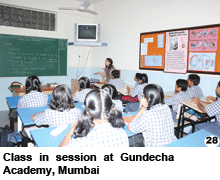 For instance in the IB-affiliated top-ranked Indus International School (estb. 2003), Bangalore, which has an enrolment of 1,100 students and 130 teachers, all class-rooms are equipped with SMART boards and every student in classes V-XII owns a laptop, the campus is fully wi-fi enabled and internet-based web 2.0 tools are widely used by teachers. According to Rakesh Pandey, ICT director at the school, integration of digital products and technologies in the curriculum has “helped teachers involve and engage students in the learning process”.
For instance in the IB-affiliated top-ranked Indus International School (estb. 2003), Bangalore, which has an enrolment of 1,100 students and 130 teachers, all class-rooms are equipped with SMART boards and every student in classes V-XII owns a laptop, the campus is fully wi-fi enabled and internet-based web 2.0 tools are widely used by teachers. According to Rakesh Pandey, ICT director at the school, integration of digital products and technologies in the curriculum has “helped teachers involve and engage students in the learning process”.
Similarly, in Chennai’s Chettinad Vidyashram, a CBSE-affiliated school, introduction of Educomp’s Smart classroom for classes I-VIII, has helped improve students’ academic performance. “Since we introduced Smart classrooms last year, there’s been a marked improvement in learning outcomes, and students now find it easier to understand concepts through visuals and animation,” says S. Amudhalakshmi, principal of the school.
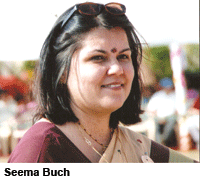 In the CISCE-affiliated Gundecha Education Academy, Kandivali, Mumbai, ICT teaching-learning aids are used from preschool to class XII. All classrooms are equipped with projectors, television, digital recorders and laptops. “Teachers use digital products and technology as supplementary teaching aids. They are the decision-makers and choose what digital content and modules are to be used in the classroom. Our experience with ICT has been very positive, enhancing the overall teaching-learning experience,” affirms Seema Buch, principal of Gundecha Academy.
In the CISCE-affiliated Gundecha Education Academy, Kandivali, Mumbai, ICT teaching-learning aids are used from preschool to class XII. All classrooms are equipped with projectors, television, digital recorders and laptops. “Teachers use digital products and technology as supplementary teaching aids. They are the decision-makers and choose what digital content and modules are to be used in the classroom. Our experience with ICT has been very positive, enhancing the overall teaching-learning experience,” affirms Seema Buch, principal of Gundecha Academy.
Although government schools have been less than enthusiastic about introducing new digital technologies into their classrooms, the small minority of Central government-promoted K-12 schools are exceptions. For instance, the 1,087 Kendriya Vidyalayas (KVs) spread across the country, acknow-ledged as role model government schools, tend to be well-equipped with fully-functional computer laboratories often housing more than 30 terminals.
According to Avinash Dikshit, commissioner of Kendriya Vidyalaya Sangathan, this academic year 50 KVs will install Smart boards and 720 schools will host projector-fitted computers in their classrooms. “We had assigned 2,500 KV teachers the task of developing online content within six months. Currently the content of 24 subjects for classes III-XII has been digitised. We will roll it out in the form of CDs in all our schools and teachers will use them as supplementary teaching aids,” says Dikshit.
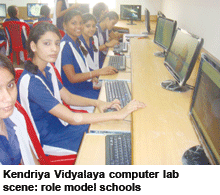 Similarly and surprisingly, the country’s 593 Central government-funded Jawahar Navodaya Vidyalayas — class VI-XII CBSE-affiliated boarding schools for rural children — are also strongly committed to ICT-aided secondary and higher secondary education. According to most evaluation and assessment reports, in terms of adapting to new digital classroom technologies JNVs are on a par with KVs, an indicator of great but largely unfulfilled enthusiasm in the rural hinterland for ICT-aided education.
Similarly and surprisingly, the country’s 593 Central government-funded Jawahar Navodaya Vidyalayas — class VI-XII CBSE-affiliated boarding schools for rural children — are also strongly committed to ICT-aided secondary and higher secondary education. According to most evaluation and assessment reports, in terms of adapting to new digital classroom technologies JNVs are on a par with KVs, an indicator of great but largely unfulfilled enthusiasm in the rural hinterland for ICT-aided education.
Nevertheless despite ICT-aided education being the flavour of the season and a majority of private schools having digitised content and outfitted classrooms with projectors and interactive whiteboards, there are a few institutions deliberately swimming against the tide. A case in point is the Shri Ram School, Delhi, ranked India’s No.1 day school in the EducationWorld Survey of Schools 2011, which has not installed whiteboards in any of its four campuses in Delhi and Gurgaon. “We don’t want to install electronic boards just because everyone else is doing so. We believe they discourage teachers from creating and developing innovative pedagogies in their classrooms. However, we have installed contemporary computer labs with over 600 personal computers in each campus,” says Mark Parkinson, director of Shri Ram School, adding that all four campuses of the school have installed digitised administration and governance systems. The ‘Shri Connect’ ERP (enterprise resource planning) software records everything from students’ performance and attendance to posting project reports and teachers’ discussions on online forums.
 Even as India’s 80,000 private schools are racing ahead in investing and adapting to ICT technologies, its 611 universities and 31,000 colleges seem to be trapped in a time warp. Projectors, SMART boards, digital content, laptops, computer tablets etc are conspicuously absent in the classrooms of the great majority of higher education institutions where teaching-learning still happens the chalk-n-talk way. “The usage of ICT in university education is way below expectation. It exists on paper and policy, but only a handful of universities have applied and integrated ICT into their curriculums and teaching practices. This is mainly because of inadequate teacher training and out-dated classroom pedagogies,” says Sanjay Ranade, head of the department of communication and journalism, Mumbai University (estb. 1857) which doesn’t provide broadband connectivity to its 5,000 students.
Even as India’s 80,000 private schools are racing ahead in investing and adapting to ICT technologies, its 611 universities and 31,000 colleges seem to be trapped in a time warp. Projectors, SMART boards, digital content, laptops, computer tablets etc are conspicuously absent in the classrooms of the great majority of higher education institutions where teaching-learning still happens the chalk-n-talk way. “The usage of ICT in university education is way below expectation. It exists on paper and policy, but only a handful of universities have applied and integrated ICT into their curriculums and teaching practices. This is mainly because of inadequate teacher training and out-dated classroom pedagogies,” says Sanjay Ranade, head of the department of communication and journalism, Mumbai University (estb. 1857) which doesn’t provide broadband connectivity to its 5,000 students.
Mumbai University is not an exception. Elsewhere too, the pace of introduction and integration of ICT into state government-owned universities is progressing at dial-up speed. For instance Bangalore University (estb. 1886), which boasts a massive number of 665 affiliated colleges, is yet to introduce interactive display boards in its classrooms, and internet access to students is available only in the library apart from the computer and visual arts departments.
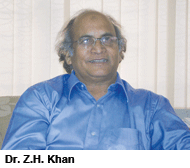 Fortunately in the capital city Delhi, universities are more ICT friendly. The Central-government funded Jamia Millia Islamia University (JMI, estb. 1920) provides 3,200 personal computers and 6,500 internet points on its 210-acre campus in south Delhi. “All hostel rooms also have internet points with some wi-fi enabled. We plan to unveil the first Smart board in our economics department this academic year. Given the easy availability of internet connectivity on campus, faculty and students are able to access the vast amount of open source material available on the web including videos posted by teachers worldwide. Moreover, we have digitised all administration, admission and financial records through an ERP system — a commendable feat for a 100-year-old institution,” says Dr. Z.H. Khan, professor of physics and director of the Centre for Information Technology at JMI.
Fortunately in the capital city Delhi, universities are more ICT friendly. The Central-government funded Jamia Millia Islamia University (JMI, estb. 1920) provides 3,200 personal computers and 6,500 internet points on its 210-acre campus in south Delhi. “All hostel rooms also have internet points with some wi-fi enabled. We plan to unveil the first Smart board in our economics department this academic year. Given the easy availability of internet connectivity on campus, faculty and students are able to access the vast amount of open source material available on the web including videos posted by teachers worldwide. Moreover, we have digitised all administration, admission and financial records through an ERP system — a commendable feat for a 100-year-old institution,” says Dr. Z.H. Khan, professor of physics and director of the Centre for Information Technology at JMI.
The country’s premier and top-ranked Delhi University (DU, estb.1922) houses an Institute of Life Long Learning on its north campus with an audio-video laboratory where any DU professor can record video lectures and post them online for viewing by students in 80 affiliated colleges. Moreover, under an ambitious first-of-its-kind initiative branded Meta University, in association with three other Central varsities — Jamia Millia Islamia, Jawaharlal Nehru University and IIT-Delhi — DU is set to roll out inter-disciplinary programmes such as B.Tech in humanities and dual Ph Ds in the online mode. Dinesh Singh, DU vice chancellor, made a detailed presentation on the concept and objectives of Meta University at the 59th CABE meeting held in Delhi on June 6. “There is a nationwide shortage of quality teachers. New digital and online technologies have to be used effectively to address this challenge. Through Meta University we want to beam lectures of the best teachers to students countrywide through virtual classrooms,” says Singh.
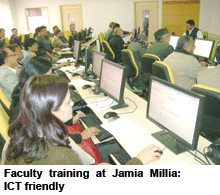 However Singh’s Meta University ran into scathing criticism from some academics attending the CABE meeting. Vinod Raina, a well-known educationist and member of the drafting committee of the Right to Education Act, argued that teachers in classrooms cannot be replaced by virtual teachers. “I teach a course in Renmin University in China and Lingnan University in Hong Kong. While these can be delivered online, the university invites me to go there physically and teach. So do all other world renowned universities which invite faculty and students from different corners of the world to create physical classrooms,” says Raina.
However Singh’s Meta University ran into scathing criticism from some academics attending the CABE meeting. Vinod Raina, a well-known educationist and member of the drafting committee of the Right to Education Act, argued that teachers in classrooms cannot be replaced by virtual teachers. “I teach a course in Renmin University in China and Lingnan University in Hong Kong. While these can be delivered online, the university invites me to go there physically and teach. So do all other world renowned universities which invite faculty and students from different corners of the world to create physical classrooms,” says Raina.
Dr. R. Govinda, vice chancellor of National University of Educational Planning and Administration (NUEPA), also believes that over-reliance on digital and online technologies to address the problem of teacher shortages is inadvisable. “If the government can’t provide adequate number of teachers then it must solve the problem rather than take shelter under ICT. University students need mentors in their classrooms. Merely uploading lectures online is not the solution. Moreover, using ICT to reach out to the masses is a mere theoretical proposition. Who has used and seen that it will work? Replacing teachers by technology is an unworkable idea,” he warns.
However confronted with an estimated shortage of 1.2 million teachers in primary and secondary education, and 100,000 faculty in higher education institutions, and bankrupt Central and state governments going slow on new teacher appointments, India has no option but to embrace ICT and online technologies to address a ballooning crisis in school and higher education. Moreover given that the conventional Indian education system cannot scale up quickly, online and technology-enabled distance education can be used to effectively distribute high-quality content delivered by the country’s best teachers to millions of students countrywide to improve learning outcomes. To address fears of educationists such as Raina and Govinda that virtual classrooms will make teachers redundant, a growing number of education institutions delivering technology-enabled distance education are adopting the hybrid model — combining traditional classroom instruction with online learning.
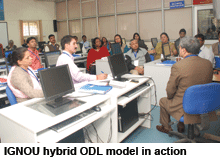 A case in point is the Delhi-based Indira Gandhi National Open University (IGNOU, estb.1985) — the world’s largest open university with an enrolment of 3 million students pursuing 500 certificate, degree and diploma courses including 60 online study programmes. This pioneer open varsity is credited with designing a unique hybrid ODL (open distance learning) model.
A case in point is the Delhi-based Indira Gandhi National Open University (IGNOU, estb.1985) — the world’s largest open university with an enrolment of 3 million students pursuing 500 certificate, degree and diploma courses including 60 online study programmes. This pioneer open varsity is credited with designing a unique hybrid ODL (open distance learning) model.
IGNOU students are educated through multiple media including traditional postal study materials, classroom teaching at its 67 regional and 3,000 learner support centres, audio-video content relayed on a television channel via Edusat satellite technology and lectures over the internet. “ICT and the internet have played a significant role in IGNOU’s expansion, and helped eliminate the deficiencies of the traditional one-way distance learning system by making it interactive and two-way,” says IGNOU pro tem vice chancellor Dr. M. Aslam.
Yet with a mere 1.6 percent of the Indian population having access to broadband connectivity, online distance education is yet to take off on a mass scale. But there’s no denying that the seeds of an ICT-enabled online education revolution have been planted, offering a much-needed lifeline to India’s crumbling higher education system.
Meanwhile, at the policy level, serious efforts are being made to address the biggest hurdle in ICT implementation in K-12 schools — inadequate teacher training. The Delhi-based NCERT’s Central Institute of Educational Technology (CIET) is developing a common syllabus for ICT teacher training. “Once completed by year-end, the curriculum — beginner, intermediate and advanced — will be made mandatory for all school teachers and students in classes VI-XII. The potential of ICT in education can be realised only when teachers are well-trained. Our programme will deliver full computer literacy to teachers — not just the ability to use Microsoft Word, but also the training to understand cyber security, video conferencing and all other digital devices,” promises Raja Ram Sharma, director of CIET which is also developing e-books and a national repository of open education resources.
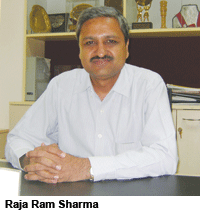 Although teacher training is a big challenge, an even bigger one is to bridge the digital divide between private and government schools. With only a tiny minority of government schools offering ICT, the road ahead to universalising digital access is long and difficult. “We cannot measure India’s ICT-in-education performance by evaluating what’s happening in private schools in urban India. A handful of private schools in the metros providing Smart classrooms and tablets to their students is a drop in the ocean. The real ICT-in-education revolution will begin only when students and teachers in government schools begin to use digital technologies and devices in their classrooms,” says Dr. Shyama Chona, former principal of Delhi Public School (DPS), R.K. Puram.
Although teacher training is a big challenge, an even bigger one is to bridge the digital divide between private and government schools. With only a tiny minority of government schools offering ICT, the road ahead to universalising digital access is long and difficult. “We cannot measure India’s ICT-in-education performance by evaluating what’s happening in private schools in urban India. A handful of private schools in the metros providing Smart classrooms and tablets to their students is a drop in the ocean. The real ICT-in-education revolution will begin only when students and teachers in government schools begin to use digital technologies and devices in their classrooms,” says Dr. Shyama Chona, former principal of Delhi Public School (DPS), R.K. Puram.
In this connection, a recent Union HRD ministry initiative which fired the public imagination and fuelled hopes of affordable technology being accessible to all in education was the Aakash computer tablet project. Launched amid great hype on October 5, 2011 under the Central government’s National Mission on Education through Information & Communications Technology (NME-ICT), Aakash was trumpeted as the world’s cheapest tablet computer priced at a mere Rs.2,250 ($40) and allocated Rs.765 crore in the Union Budget 2012-13, with the HRD ministry setting itself a target of delivering 10 million tablets to post-secondary students across India this fiscal.
However since then a spate of media reports indicate that all is not well with the project, outsourced by the ministry to Data Wind Ltd, a UK-based developer of wireless web access products and services. IIT-Bombay which was roped in to approve the company’s prototype tablet for the market, has aired strong reservations about poor quality and performance of the Aakash tablet.
Nevertheless despite India’s ICT-in-education initiatives struggling in choppy waters, they are collectively moving in the right direction. Certainly they have awakened all stakeholders — government, private education technology companies, schools, colleges, universities, teachers and students — to the immense possibilities of digital technologies to upgrade and rejuvenate Indian education.
The limited ICT revolution spear-headed by the country’s private schools and perceptive ICT companies now needs to expand its bandwidth to include languishing government schools, colleges and universities of small town and rural India. For cruelly neglected Indian primary, secondary and higher education, new information and communications technology offers a magical opportunity to rapidly create 21st century learning environments. It must not be missed.
With Hemalatha Raghupathi (Chennai); Praveer Sinha (Mumbai) & Paromita Sengupta (Bangalore)

























